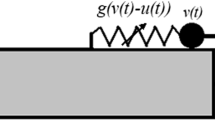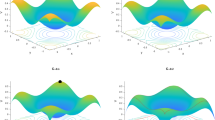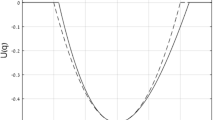Abstract
We consider the escape of an initially excited dynamical system with two degrees of freedom from a potential well. Three different benchmark well potentials with different topologies are explored. The main challenge is to reveal the basic mechanisms that govern the escape in different regions of the parametric space and to construct appropriate asymptotic approximations for the analytic treatment of these mechanisms. In this study, numerical and analytical tools are used to classify and map the different escape mechanisms for various initial conditions and to offer the analytic criteria predicting the system’s behavior for those cases.













Similar content being viewed by others
Data Availability
Data sharing is not applicable to this article as no datasets were generated or analyzed during the current study.
References
Ibrahim, H., Lefebvre, C., Bandrauk, A.D., Staudte, A., Légaré, F.: H2: the benchmark molecule for ultrafast science and technologies. J Phys B: Atomic, Molec Optic Phys. 51, 042002 (2018)
Suzuki, H., Shimakawa, H., Kumada, A., Sato, M.: Molecular dynamics study of ionic conduction in epoxy Resin. IEEE Trans. Dielect. Electr. Insul. 29(1), 170–177 (2022). https://doi.org/10.1109/TDEI.2022.3148462
Koon, W.S., Lo, M.W., Marsden, J.E., Ross, S.D.: Heteroclinic connections between periodic orbits and resonance transitions in celestial mechanics. Chaos Interdiscip. J. Nonlinear Sci. 10, 427 (2000)
Arnold, V. I., Kozlov, V. V., & Neishtadt, A. I.: Mathematical aspects of classical and celestial mechanics. Vol. 3 (2007)
Cao, J., Zhou, S., Wang, W., Lin, J.: Influence of potential well depth on nonlinear tristable energy harvesting. Appl. Phys. Lett. 106, 173903 (2015)
Barone, A., Paternò, G.: Physics and applications of the Josephson effect. Wiley (1982). https://doi.org/10.1002/352760278X
Maki, A., Miino, Y., Umeda, N., Sakai, M., Ueta, T., Kawakami, H.: Nonlinear dynamics of ship capsizing at sea. Nonlinear Theory Appli, IEICE. 13, 2–24 (2022)
Naik, S., Ross, S.D.: Geometry of escaping dynamics in nonlinear ship motion. Commun. Nonlinear Sci. Numer. Simul. 47, 48–70 (2017)
Zhang, W.M., Yan, H., Peng, Z.K., Meng, G.: Electrostatic pull-in instability in MEMS/NEMS: a review. Sens. Actuators, A 214, 187–218 (2014)
Younis, M.I., Abdel-Rahman, E.M., Nayfeh, A.: A reduced-order model for electrically actuated microbeam-based MEMS. J. Microelectromech. Syst. 12, 672–680 (2003)
Alhussein, H., Daqaq, M.F.: Potential well escape via vortex-induced vibrations: a single-degree-of-freedom analysis. Physica D 426, 133001 (2021)
Gendelman, O.V.: Escape of a harmonically forced particle from an infinite-range potential well: a transient resonance. Nonlinear Dyn. 93(1), 79–88 (2018)
Gendelman, O.V., Karmi, G.: Basic mechanisms of escape of a harmonically forced classical particle from a potential well. Nonlinear Dyn. 98(4), 2775–2792 (2019)
Farid, M., Gendelman, O.V.: Escape of a forced-damped particle from weakly nonlinear truncated potential well. Nonlinear Dyn. 103, 63–78 (2021)
Attila, G., Fidlin, A., Gendelman, O.: On the escape of a resonantly excited couple of particles from a potential well. Nonlinear Dyn. 104(1), 91–102 (2021)
Chacón, R., Martínez, P.J., Marcos, J.M., Aranda, F.J., Martínez, J.A.: Ratchet universality in the bidirectional escape from a symmetric potential well. Phys. Rev. E 103, 022203 (2021)
Seoane, J.M., Sanjuán, M.A.F.: New developments in classical chaotic scattering. Rep. Prog. Phys. 76, 016001 (2012)
Nieto, A.R., Seoane, J.M., Sanjuán, M.A.F.: Noise activates escapes in closed Hamiltonian systems. Commun. Nonlinear Sci. Num. Simulation. 105, 106074 (2022)
Nieto, A.R., Seoane, J.M., Sanjuán, M.A.F.: Final state sensitivity in noisy chaotic scattering. Chaos, Solitons Fractals. 150, 111181 (2021)
Contopoulos, G., Kandrup, H.E., Kaufmann, D.: Fractal properties of escape from a two-dimensional potential. Physica D 64, 310–323 (1993)
Nayeemid, R., Bazziid, S., Sadeghiid, M., Hoganid, N., Sternadid, D.: Preparing to move: Setting initial conditions to simplify interactions with complex objects. PLoS. Comput. Biol. 17, 1009597 (2021)
Zotos, E.E., Jung, C.: A three-dimensional dynamical model for double-barred galaxies, escape dynamics and the role of the NHIMs. Commun. Nonlinear Sci. Numer. Simul. 80, 104989 (2020)
Alhussein, H., Daqaq, M.F.: Potential well escape in a galloping twin-well oscillator. Nonlinear Dyn. 99(1), 57–72 (2020)
Liu, X., Chen, G.S.: Friction Dynamics: Principles and Applications. Woodhead Publishing, UK (2016)
Shang, H.: Pull-in instability of a typical electrostatic MEMS resonator and its control by delayed feedback. Nonlinear Dyn. 90(1), 171–183 (2017)
Funding
The authors are very grateful to Israel Science Foundation (Grant 2598/21) for financial support.
Author information
Authors and Affiliations
Corresponding author
Ethics declarations
Conflict of interest
The authors have no relevant financial or non-financial interests to disclose. The authors declare no conflicts of interest.
Additional information
Publisher's Note
Springer Nature remains neutral with regard to jurisdictional claims in published maps and institutional affiliations.
Appendix
Appendix
1.1 The lower boundary of the escape energy level
The escape of a dynamical system from a potential well is impossible if the initial energy is less than the value of the potential at its saddle points (\(E_{{{\text{sp}}}}\)). For any initial energy \(E_{0} < E_{{{\text{sp}}}}\) the iso-potential curves are closed, and the is bounded, while for the exact \(E_{0} = E_{{{\text{sp}}}}\) the closed counters of the iso-potential curves are broken, and escape channels are formed (cf. Fig. 7). Therefore, the lower limit of the escape energy level can be derived from the analysis of the total potential of the system.
For the cubic and biquadratic potentials, one can easily find the stationary point as a function of stiffness by setting the gradient of the total potential to zero. Further analysis shows that both potentials exhibit a saddle-node bifurcation for the control parameter-\(\varepsilon\), the different system structures present in Fig. 14. With the help of the second partial derivative test, one can classify the saddle point which satisfies the following requirement.
Hence, the lower boundary of the escape energy for each IC is determined by the following form for the biquadratic potential and the cubic potential, respectively
Rights and permissions
Springer Nature or its licensor (e.g. a society or other partner) holds exclusive rights to this article under a publishing agreement with the author(s) or other rightsholder(s); author self-archiving of the accepted manuscript version of this article is solely governed by the terms of such publishing agreement and applicable law.
About this article
Cite this article
Engel, A., Ezra, T., Gendelman, O.V. et al. Escape of two-DOF dynamical system from the potential well. Nonlinear Dyn 111, 3019–3034 (2023). https://doi.org/10.1007/s11071-022-08000-6
Received:
Accepted:
Published:
Issue Date:
DOI: https://doi.org/10.1007/s11071-022-08000-6





